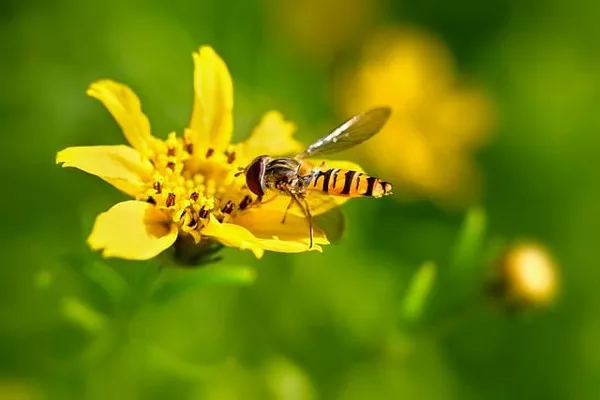In the bustling tapestry of a flower garden, a mesmerizing kaleidoscope of colors, intricate patterns, and alluring fragrances comes alive when viewed through the lens of a bee. These industrious pollinators possess a unique and enchanting perspective that profoundly influences their interactions with the botanical realm. In this captivating exploration, we embark on a journey deep into the intricate realm of bee vision, peeling back the layers to uncover how flowers appear to these vital pollinators. By delving into the captivating interplay between blooms and bees, we gain a richer understanding of the exquisite partnership that sustains our natural world.
See Also: Fluttering Beauty: Flowers That Attract Butterflies to Garden
1. Vibrant Color Palette: Nature’s Living Canvas
The radiant spectrum of colors displayed by flowers beckons both human and bee observers alike. However, the eyes of bees decode this palette differently, thanks to their distinct visual capabilities. They possess heightened sensitivity to blue and ultraviolet (UV) wavelengths—a remarkable adaptation. This heightened sensitivity allows them to perceive floral hues that are often invisible to the human eye, transforming a field of flowers into a breathtaking symphony of vibrant blues, delicate violets, and ethereal ultraviolet glows.
2. UV Signposts: Navigating Floral Pathways
For bees, flowers reveal a hidden world of signposts painted in ultraviolet hues. These nectar guides, often intricately etched on petals, serve as illuminated pathways leading pollinators toward the flower’s nectar-rich heart. What may appear to human observers as a simple, single-colored petal harbors a complex tapestry of UV patterns that guide bees with astonishing precision. It is a silent communication between the floral kingdom and its winged visitors.
3. Electric Dance of Patterns: Petal Landscapes Alight
Within the enchanting realm of bee vision, petals take on a new dimension. They come alive with mesmerizing electric patterns—unique adornments that guide bees as they embark on their vital pollination journey. Flowers like the snapdragon possess specialized cells known as “bullseyes,” which reflect UV light and create landing platforms visible exclusively to bees. This natural landing strip ensures that bees alight with grace, touching down on precisely the right spot to facilitate pollination—a choreography of nature’s design.
4. Sweet Trails of Nectar: Illuminating Floral Centers
The heart of a flower, brimming with nectar, becomes an iridescent beacon in the eyes of a bee. As these diligent foragers explore the depths of blossoms, they follow the radiant glow of nectar guides—often UV-reflecting pathways that lead them to the flower’s life-sustaining sustenance. These guides form a luminous map, guiding bees through a scented labyrinth of petals to collect the nectar and pollen that fuel their colonies.
5. Transforming Night into Day: Blooming Under Moonlight
Certain flowers hold a captivating secret that reveals itself under the gentle glow of the moon. While the human eye may perceive darkness, bees experience an enchanting transformation. Flowers like evening primroses emit UV patterns, hidden during the day but radiant under the moonlight’s embrace. This nocturnal adaptation allows bees to continue their essential pollination activities, revealing the hidden nocturnal dance of the natural world.
In conclusion
In the tapestry of nature, the world of flowers, as perceived by bees, emerges as a living masterpiece—a symphony of colors, patterns, and signals that orchestrate the intricate dance of pollination. The vibrant color palette, UV signposts, electric patterns, nectar trails, and nocturnal transformations collectively create a captivating and enchanting landscape, woven with delicate interactions. As skilled pollinators flit from bloom to bloom, they weave the delicate tapestry of life that sustains both their colonies and the diverse array of plants that rely on their essential pollination prowess. This interplay between flowers and bees stands as a testament to the intricate beauty and complexity of the natural world—an enduring collaboration that underscores the remarkable synergy between the botanical realm and its buzzing allies.


